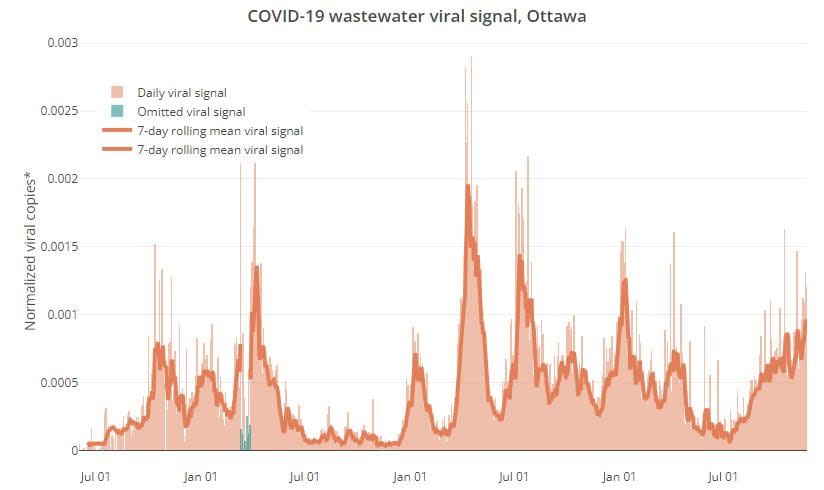Most Ottawa COVID-19 signals are very high

Recent developments:
Ottawa's COVID-19 numbers are mostly rising or stable.
Individual trends are mostly very high.
RSV activity is high, flu numbers generally low.
Fifteen more local COVID deaths have been reported.
The latest
The city's COVID-19 numbers to watch are mostly very high, and they are either stable or rising in this week's Ottawa Public Health (OPH) updates.
The latest numbers show a high amount of respiratory syncytial virus (RSV) activity, while flu trends are mostly low.
OPH says the city's health-care institutions remain at a high risk from respiratory illnesses, as they have been since early September.
The city is about to enter the traditional respiratory season — December through February — with more coronavirus signal in its wastewater than at this point over the past three years, less flu signal than last year at this time, and roughly the same amount of RSV.
Experts recommend people cover coughs and sneezes, wear masks, keep their hands and often-touched surfaces clean, stay home when sick and keep up to date with COVID and flu vaccines to help protect themselves and vulnerable people.
Wastewater
Data from the research team shows, as of Nov. 23, the average coronavirus wastewater level is again rising to its highest point since mid-January 2023. OPH considers this very high.

Researchers have measured and shared the amount of novel coronavirus in Ottawa's wastewater since June 2020. The most recent data is from Nov. 23, 2023. (613covid.ca)
Hospitals
In the past week, the average number of Ottawa residents in local hospitals for COVID-19 has risen to 79, including two patients in an ICU.
A separate count — which includes patients who either tested positive for COVID after being admitted for other reasons, were admitted for lingering COVID complications or were transferred from other health units — drops after two weeks of significant increases.

Ottawa Public Health has a COVID-19 hospital count that shows all hospital patients who tested positive for COVID, including those admitted for other reasons and who live in other areas. (Ottawa Public Health)
There were 54 new patients in the previous week. OPH sees this as a high number of new hospitalizations.
Tests, outbreaks and deaths
The city's weekly average test positivity rate sits at about 20 per cent. It has stayed between 15 and 20 per cent this month. OPH categorizes this as very high, up from high the last few weeks.
There are 38 active COVID outbreaks — almost all are in either retirement homes or hospitals. The total remains stable but there is a very high number of new outbreaks.
The health unit reported 292 more COVID cases in the last week and four more COVID deaths.
It also said it added 25 more deaths to its count after the province changed what it considers a COVID death. The new total sits at 1,171 reported resident COVID deaths, including 154 so far this year.
OPH's next COVID vaccination update is expected next week.
Across the region
Spread and vaccination
The Kingston area's health unit says its COVID trends are stable at mostly moderate levels and it's in a high-risk time for transmission. Flu indicators are low and RSV trends are high and rising.
The area's average coronavirus wastewater reading is considered very high and rising, while its average COVID-19 test positivity rate is a moderate, stable 14 per cent.
The Eastern Ontario Health Unit (EOHU) says it's in a high-risk time for COVID. Its test positivity of 21 per cent and 15 active outbreaks are each considered very high, though its wastewater reading is moderate and dropping.
Hastings Prince Edward (HPE) Public Health says 15 per cent of its residents have had a COVID vaccine in the last six months, up from 13 per cent last week.
Hospitalizations and deaths
The EOHU has 22 COVID hospitalizations, which it also considers very high.
The Kingston area's health unit says it has 14 active COVID-19 patients in its hospitals, including anyone living in a different health unit. That is categorized as moderate and dropping.
HPE, like Ottawa, gives a weekly COVID hospital average: a stable 17, with three ICU patients.
Western Quebec has a stable 78 hospital patients with COVID. The province says there has been one more COVID deaths there for a total of 522.
The EOHU has had seven more reported COVID deaths in the last week. The health unit for Leeds, Grenville and Lanark (LGL) counties reported three more COVID deaths.
LGL data goes up to Nov. 19. Renfrew County's updates come every second Thursday.


